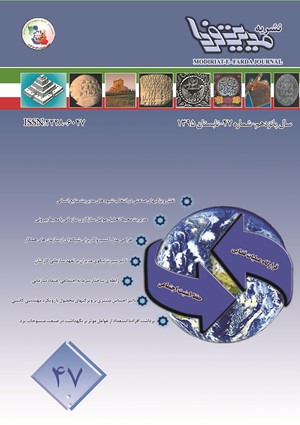تأثیر احساس مشتری بر ویژگیهای محصول با رویکرد مهندسی کانسی
محورهای موضوعی : مدیریت تحقیق و توسعه
غلامرضا هاشم زاده
1
![]() ,
محمدرضا بهرامی
2
,
محمدرضا بهرامی
2
1 - تهران
2 - دانشگاه آزاد اسلامی واحد تهران جنوب
کلید واژه: مهندسی کانسی, طراحی محصول, احساسات مشتری,
چکیده مقاله :
امروزه تولیدکنندگان باوجود رقابتهای شديد جهت افزایش کیفیت و تأمین نظرات مشتریان خود در کنار کاهش هزینه نيازمند طراحی و ساخت محصولاتي میباشند كه در آن به عواطف و احساسات حقیقی کاربران توجه شده باشد. مهندسی کانسی یکی از مناسبترین روشها برای ارتقاء کیفیت محصول و رضایت مشتریان است که توجه ویژهای بر احساسات آنها در مورد محصول دارد. این مقاله ضمن معرفی مهندسی کانسی و تکنیکهای مرتبط با آن به دنبال تبدیل احساسات و تأثیرات عاطفی بر پارامترهای طراحی بوده و ضمن بررسی مطالعات پیشین از طریق مصاحبه با مشتریان خمیردندان مریدنت، 83 لغت کانسی كه معرف احساسات مشتريان از محصول بوده شناسايي و پس از غربالگری، 23 لغت تأثيرگذار بر احساس مشتريان را در سه بخش ویژگیهای ذاتی، ظاهري و عوامل قابلکنترل، جهت دستيابي به ضرايب اهميت معقول تر در روش ANP تقسیمبندی نموده است سپس با روش ANP و DIMATEL لغات کانسی توسط خبرگان سازمان رتبهبندی كه درنتیجه ویژگیهای ذاتی مهمتر قلمداد شدند. در مرحله بعد جهت بررسی نقاط قوت و ضعف ازنظر مشتریان، خمیردندان مریدنت با محصولات مشابه 3 رقیب اصلی با استفاده از تکنیک ANP مقایسه و درنهایت، وزن و ميزان اهميت نهايي معيارها تعيين گرديد.
Abstract Despite the intense competitions to increase the quality, live up to the expectations of the customers, and decrease the costs, nowadays manufacturers need to design and make products in which customer’s real emotions and feelings should be taken into account. Paying due attention to customer’s feelings about the product, Kansei engineering is one of the most appropriate methods to improve the quality of product and customer’s satisfaction. In addition to introducing Kansei engineering and its relevant techniques, this paper was aimed at translating feelings and emotional impacts on the design parameters. Reviewing the literature through interviewing Merident Toothpaste customers, 83 Kansei words representing customer’s feelings about the product were identified. After screening, 23 words influencing customer’s feelings were divided into three parts including natural features, apparel ones, and controllable factors in order to obtain more rational coefficients of importance in ANP method. Using ANP and DIMATEL methods, then the Kansei words were graded by the experts of organization; consequently, natural features were considered more important. Employing ANP method in the next step, Merident Toothpaste was compared with the similar products manufactured by 3 main competitors to investigate the advantages and disadvantages with respect to the opinions of customers. Eventually, the final weight and importance of criteria were determined.
خاکی، غلامرضا. (1382) روش تحقیق در مدیریت. تهران: انتشارات دانشگاه آزاد اسلامی.
سرمد، زهره، بازرگان، عباس و حجازي، الهه. (1387). روشهای تحقيق در علوم رفتاري (چاپ پنجم). تهران: انتشارات آگاه.
کریم پور لاله دشتی، میلاد، رضا حافظی، امیر ناصر اخوان و علیرضا اژدری. (1393). آینده خودروسازی در ایران، درگرو توجه به گرایشات مشتری (تحلیلی بر پایه احساسات مشتری)، چهارمین کنفرانس بینالمللی و هشتمین کنفرانس ملی مدیریت فناوری، جزیره کیش، انجمن مدیریت فناوری ایران.
باقری، سیده مهسا. (1392). بهکارگیری مهندسی کانسی برای طراحی داخلی مبتنی بر احساس کاربر، سومین همایش ملی معماری داخلی و دکوراسیون، اصفهان، موسسه آموزش عالی دانشپژوهان.
حمیدیان دیوکلایی، لیلا السادات و عباسعلی شاهرودی. (1393). طراحی مدارس برای نوجوانان مبتنی بر مهندسی احساسگرا، دومین کنفرانس ملی جامعهشناسی و علوم اجتماعی، تهران، موسسه اطلاعرسانی نارکیش.
نقیبی راد، پرستو و عباسعلی شاهرودی. (1393). مهندسی کانسی روشی نوین در بهکارگیری احساسات کاربران در فرآیند طراحی نماهای شهری، همایش ملی معماری، عمران و توسعه نوین شهری، تبریز، کانون ملی انجمنهای صنفی مهندسان معمار ایران.
Buyukozkan, G., & Ozturkcan, D. (2010). An Integrated Analytic Approach for Six Sigma Project Selection. Expert Systems with Applications, 37(8), 5835-5847.
Cupchik, G. (2004). The Design of Emotion. New York: Taylor & Francis press.
Desmet, P. (2004). From Disgust to Desire: How Products Elicit Emotions. New York: Taylor & Francis press.
Ekman, P. (1999). Basic Emotions. In T. Dalgleish & T. Power, Handbook of Cognition and Emotion. New York: Wiley.
Saaty, T. L. (1980). The Analytic Hierarchy Process. New York: McGraw-Hill International.
Schutte, S. (2002). Designing Feelings in to Product. (M.S. Thesis), Linkoping University, Sweden.
Meade, l., & Sarkis, j. (1999). A Methodology for Analyzing Alternatives for Agile Manufacturing Business Processes. International Journal of Production Research, 37(2):241-261.
Nagamachi, M., Komatsu, K., Ichitsubo, M., Nishino, T., & Ishihara, S. (2000). Kansei of the Elderly and Community Ergonomics. 44th Annual Meeting of International Ergonomics Association and Human Factors and Ergonomics Society. San Diego, CA.
Norman, D. (2004). Emotional Design, Basic Books pub.135-161


